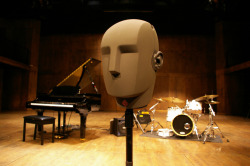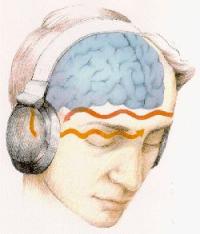 March 4, 2012
March 4, 2012 Binaural recording vs binaural beats – what's the difference?
Same word, but two very different things
The word “binaural” is garnering a lot of interest these days. By definition, it literally just means “having or relating to two ears.” Human beings (along with many other animals) experience all sound binaurally.
But confusingly, the word “binaural” can be applied to a few very different things – most applicably, “binaural recording” (aka “binaural audio”), and “binaural beats” (aka “binaural brainwaves”).
So, to help set the record straight and get everyone on the same page, here’s a quick rundown on the differences between binaural recording and binaural beats.
Binaural recording
 Kall Binaural Audio’s KU-100 dummy head microphoneThis is what we here at Kall Binaural Audio do. Binaural recording uses two microphones placed inside the ears of either a person or a dummy head to record sound the way we experience it. This type of recording is based on what’s called the “Head Related Transfer Function” (or HRTF), which characterizes how we can tell where a sound is coming from around us.
Kall Binaural Audio’s KU-100 dummy head microphoneThis is what we here at Kall Binaural Audio do. Binaural recording uses two microphones placed inside the ears of either a person or a dummy head to record sound the way we experience it. This type of recording is based on what’s called the “Head Related Transfer Function” (or HRTF), which characterizes how we can tell where a sound is coming from around us.
Since they are located on opposite sides of our head, our subconscious brain picks up on the differences in timing and volume as a sound reaches our ears. Suppose someone claps their hands somewhere to your left. The sound reaches your left ear first because it’s closer, and then travels around to your right ear. Plus, because your skull is physically blocking some of the sound from your right ear, the clap will be quieter by the time it gets there.
Now, something very cool happens when you listen back to a binaural recording. As long as you keep the left and right channels completely seperate (most easily done with headphones), your brain will “decode” the sound as if you were hearing it in the exact spot it was recorded. This means that with just a regular set of headphones, you can hear sounds to your left and right, as well as in front, behind, above, below, and everywhere in between.
It’s the most immersive 3D sonic experience you can create, and it’s what we at Kall Binaural Audio get out of bed for everyday.
Here’s an example of a musical binaural recording:
And a sound effect:
Binaural beats
 Binaural beatsCalm your mind! Heal your brain! “Digital Drugs!” These are some slogans you’ll see if you search Google for binaural beats. Like binaural recording, they rely on both of your ears and headphones to work. The reason why is based on the science of sound, which musicians also use to tune their instruments.
Binaural beatsCalm your mind! Heal your brain! “Digital Drugs!” These are some slogans you’ll see if you search Google for binaural beats. Like binaural recording, they rely on both of your ears and headphones to work. The reason why is based on the science of sound, which musicians also use to tune their instruments.
When you play two pitches that are very close but not exactly the same – say, 100 Hz and 105 Hz – the sound waves interact with each other and you hear a strange pulsating pattern (aka “beating”) in the sound, that is equal to the difference in pitch between the sounds (in this case, 5 Hz). Now, suppose you played the first pitch into only your left ear and the second, slightly different pitch in your right ear with headphones. Even though the two sounds are not interacting in the air at all, your brain will still “hear” the pulsing beats between them.
This is where the brainwave part of it comes in. Your brain naturally “vibrates” at different frequencies at different points in your day, and there are different frequencies associated with different moods and states of being. For example, 4-7 Hz is associated with deep relaxation. It’s said that by stimulating your brain by listening to binaural beats, you can change this frequency to affect your mood. Some people claim it can be used to meditate, stimulate your hormones, treat a wide range of disorders, and even simulate the effects of some drugs.
Here’s an example of a binaural beat between two pitches:
And one mixed into music:
In conclusion…
Though they both make use of human binaural hearing, binaural recording and binaural beats are two very different things. Hopefully this article sheds some light on the difference, and encourages you to grab your headphones and check out each one in more detail.
Here’s some suggested reading:
The KU-100 Technical Specifications
A Brief History of Binaural Audio
Head Related Transfer Function (Wikipedia)
Binaural Beats (Wikipedia)
BY: ALEX KALL
I’m the owner and head engineer here at Kall Binaural Audio. Aside from my career/love affair with binaural audio recording, I’ve worked as Symphony Nova Scotia’s stage manager and marketing coordinator, and am also a freelance bass player and designer.
 Future Of Music,
Future Of Music,  Psychology,
Psychology,  Technology,
Technology,  recording | tagged
recording | tagged  Kall Binaural Audio,
Kall Binaural Audio,  binaural,
binaural,  binaural beats,
binaural beats,  brainwaves |
brainwaves |  1 Reference
1 Reference 





Reader Comments